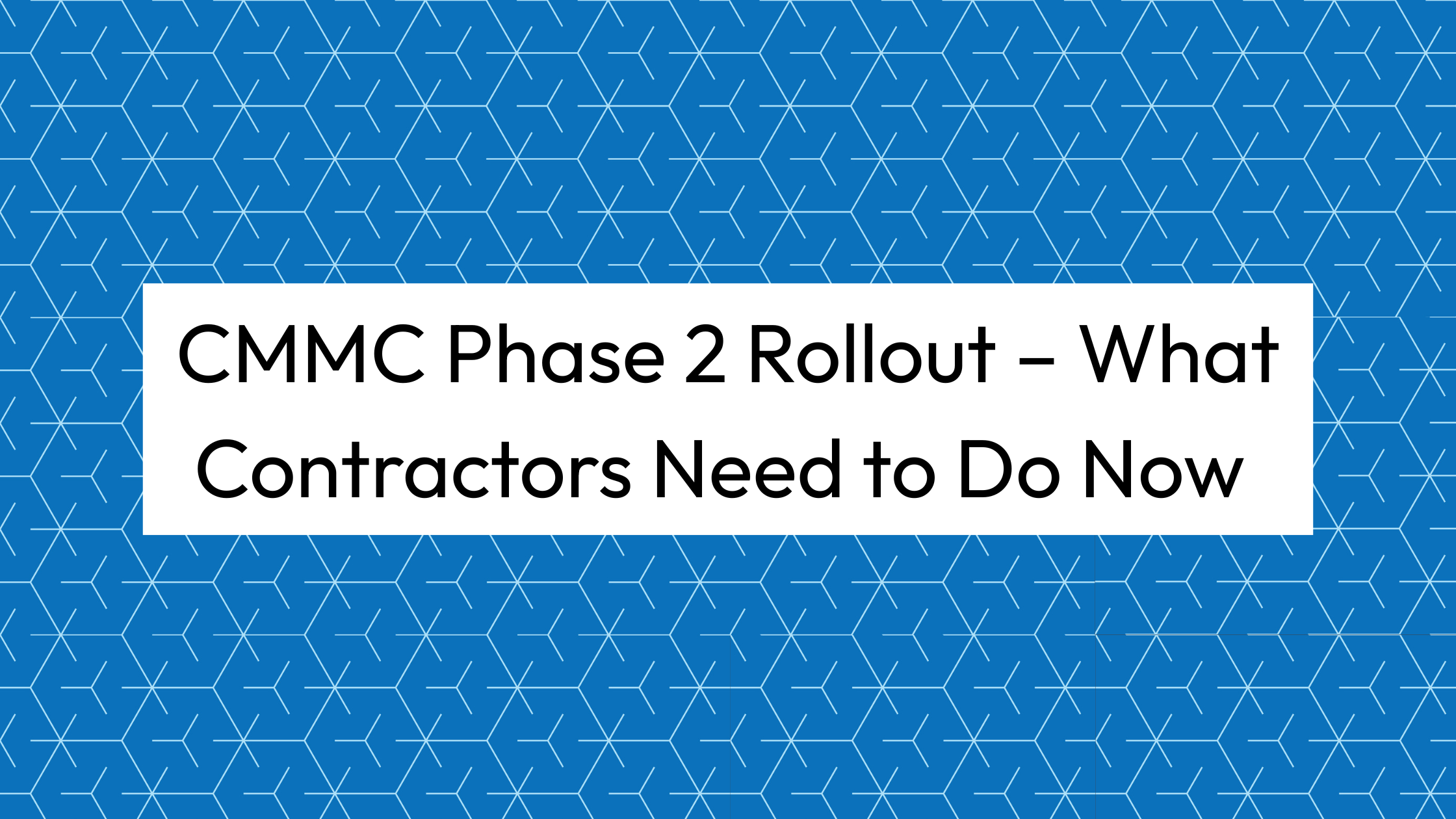
Introduction
If you're a defense contractor, a small to medium-sized business in the Department of Defense (DoD) supply chain, or a compliance officer, then CMMC 2.0 should already be on your radar. With Phase 2 of the CMMC 2.0 rollout on its way, now is the time to act, especially if your business relies on DoD contracts to stay competitive. Although the official rollout hasn’t hit yet, the government is expected to start requiring CMMC compliance as early as late summer or early fall. That means contractors in scope can’t afford to wait.
Phase 2 of CMMC 2.0 introduces a significant change which is mandatory third-party assessments for Level 2 certification. Unlike Phase 1, which allowed for self-assessments, this next phase will require businesses handling Controlled Unclassified Information (CUI) to pass a certification audit from a Certified Third-Party Assessment Organization (C3PAO). This change raises the bar for cybersecurity certification and calls for more rigorous documentation, planning, and preparation.
In this blog, we’ll break down how Phase 2 affects businesses bidding on DoD contracts, common compliance pitfalls, and how to streamline your path to CMMC compliance through effective cybersecurity assessments and documentation. We’ll also explore how Managed Service Providers (MSPs) can support your efforts and ensure your cybersecurity framework is audit-ready.
Whether you're new to CMMC or already working toward certification, the Phase 2 rollout is a critical turning point. The timeline may seem flexible, with some reports saying it’ll begin in 2026, but the requirements are already in motion. To stay eligible for future contracts and protect your place in the defense supply chain, preparation needs to happen now, not when the final rule kicks in.

How CMMC 2.0 Phase 2 Affects Businesses Bidding on DoD Contracts
Phase 2 of the CMMC 2.0 rollout represents a major shift for businesses pursuing Department of Defense (DoD) contracts. Under this phase, contractors handling Controlled Unclassified Information (CUI) must undergo a third-party cybersecurity certification to achieve Level 2 compliance. This means businesses can no longer rely on self-assessments alone since they’ll need to pass an audit conducted by a Certified Third-Party Assessment Organization (C3PAO) to remain eligible for certain contracts.
This requirement affects not only large defense primes, but also small and medium-sized businesses (SMBs) within the broader DoD supply chain. If your company supports prime contractors or handles sensitive project data, you’ll likely fall within the scope of these updated compliance measures. Bidding on new DoD contracts, or even maintaining current ones, will require proof of certification, making compliance a non-negotiable priority.
Another key change is timing. While Phase 2 officially begins later on, the government is expected to require CMMC 2.0 compliance as early as late summer or early fall for some contracts. That means if you plan to bid on or renew a DoD contract in the near future, you need to meet the new cybersecurity requirements now, not after Phase 2 formally begins.
The bottom line? If you’re not CMMC 2.0 ready, you’re at risk of losing valuable business opportunities. Phase 2 raises the standard for data protection and enforces a new level of accountability for all organizations within the defense industrial base. Businesses that prepare early will have a clear competitive edge when bidding on contracts and the peace of mind that comes with being compliant.
Common CMMC 2.0 Pitfalls and Compliance Challenges
While achieving CMMC 2.0 compliance is essential for securing and maintaining DoD contracts, it comes with its own set of challenges. The five most common pitfalls businesses face and how to avoid them are:
1. Underestimating the Time and Resources Needed
Many contractors think Level 2 compliance can be achieved quickly, but the reality is it takes months of planning, documentation, remediation, and testing. Misjudging the effort required often leads to missed deadlines and lost contracts. Working with a Managed Service Provider (MSP) can help keep you on track.
2. Incomplete or Inaccurate Documentation
CMMC 2.0 demands thorough documentation, especially your System Security Plan (SSP) and Plan of Action and Milestones (POAM). These aren't just boxes to check. Your SSP outlines how you implement and maintain NIST 800-171 controls, while your POAM details how you’ll address any gaps. Poor or missing documentation is a top reason for audit failures and contract disqualification.
3. Failure to Identify All CUI
You can’t protect what you don’t know you have. Many businesses struggle to define the scope of their Controlled Unclassified Information (CUI). Overlooking CUI, like personally identifiable information, technical specs, or internal DoD data, can result in major compliance gaps. Accurate identification is essential for being audit ready.
4. Relying Solely on In-House IT Teams
Your internal IT team might be great at day-to-day operations, but CMMC requires specialized expertise. From implementing NIST controls to preparing for third-party assessments, MSPs bring the strategic insight and tools needed to meet and maintain compliance, so your team can stay focused on business priorities.
5. Lack of Continuous Monitoring and Maintenance
CMMC compliance isn’t a one-time project. Without ongoing monitoring, updates, and patch management, your environment can quickly fall out of compliance. To keep winning DoD contracts, you must maintain compliance, not just meet it once. Ignoring updates or POAM tasks could mean lost work and future risk as requirements evolve.
How To Streamline Compliance
Before a CMMC 2.0 audit, it’s essential to conduct a Gap Assessment, which is a strategic review that identifies weaknesses in your current security posture and outlines actionable steps for improvement. Whether you're aiming for Level 1 or Level 2 certification, this early step can prevent costly surprises during the audit process.
A Managed Service Provider (MSP) can be instrumental in this phase. By thoroughly evaluating your cybersecurity environment, an MSP can pinpoint deficiencies and create a clear remediation plan to close those gaps and align your systems with CMMC requirements.
Once gaps are identified, the focus shifts to implementing the necessary security controls from strengthening access management and improving threat detection to enabling continuous monitoring of sensitive data. A trusted MSP can streamline this process, helping you not only meet but also maintain compliance over time.
When it’s time for the audit, your MSP can guide you through the preparation, recommend qualified CMMC Third-Party Assessment Organizations (C3PAOs), and help gather and organize the documentation needed, such as System Security Plans (SSPs), POAMs, and audit evidence. By partnering with an experienced MSP, you free up internal resources and stay focused on running your business.
.png?width=262&height=262&name=_April%20Blog%20Week%204%20-%20CMMC%20Phase%202%20-%20gen%20manufacturing%20(1).png)
Partnering with an MSP for CMMC Phase 2 Success
Navigating the CMMC Phase 2 rollout doesn’t have to be overwhelming. A Managed Service Provider (MSP) with compliance expertise can help you stay ahead of evolving requirements by guiding your organization through assessments, implementing controls, maintaining documentation, and preparing for audits. From identifying Controlled Unclassified Information (CUI) to managing continuous monitoring and updates, MSPs play a vital role in helping you achieve and sustain compliance without taking focus away from your core business.
Ready to see where you stand? Sign up for a Optimization Plan today to assess your current security posture, uncover any gaps, and get a clear roadmap to CMMC 2.0 readiness. Don’t wait until Phase 2 is in full swing, secure your future DoD contracts now by making compliance a priority.




